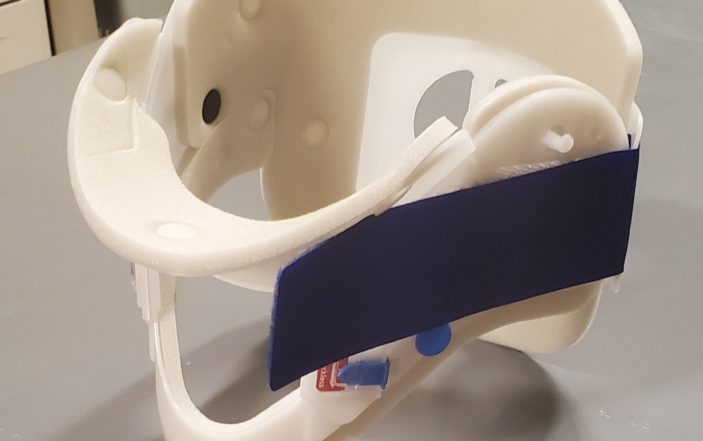Few procedures are more prevalent in prehospital trauma care than the application of the cervical collar. The evidence behind the application of the collar is as unstable as the cervical spine injuries hey seek to prevent. The use of the cervical collar is not benign, with known risks of increasing ICPs and complicating airway management.
Practice patterns around cervical collars owe much to the inertia of old guidelines based on decades old evidence1. The emergency physician occupies a unique position to advocate for patients and evidence-based care.
The two questions that should be asked regarding collar application are:
1) do they prevent further injury
2) do they cause injury? The answer to both of these questions is “potentially.”
There remains a dearth of evidence in support of cervical collars and their use is based on the concept that immobilization of the cervical spine will prevent further injury should one even exist in the undifferentiated trauma patient.[1] There is evidence that there is no difference in neurologic outcomes between awake and alert patients immobilized and those not immobilized with cervical collars.[2]
A 2015 BMJ study simulated extrication of the alert adult patient after a motor vehicle crash and showed no significant difference between the cervical motion of collared patients and uncollared patients self-extricating.[3] It is reasonable to assert that patients with a potential cervical spine injury who are awake, alert, and cooperative, with no neurologic deficits are capable of maintaining their own spine.
The Eastern Trauma Guidelines even recommend C-collar clearance of obtunded/intoxicated patients after negative high-quality C-spine imaging in certain circumstances based on a systematic review of the available literature.[5]
Patients also frequently arrive with collars that are of inappropriate size, ineffectively immobilizing the spine and potentially exacerbating the issue of increased ICPs caused by even the most proper fitting collar. Patients with ankylosing spondylitis (AS), rheumatoid arthritis (RA), and other degenerative spinal diseases often experience extraordinary discomfort and potential injury in the cervical collar.
There are no RCTs or retrospective studies showing that collars have worsened TBI secondary to increased ICPs, but ICPs can increase as much as 4 mmHg after collar application and decrease by as much as 3 mmHg after their removal.[4] Removing a cervical collar as soon as possible can minimize discomfort and remove the risk of worsening ICP and by theoretical extension, TBI.
The patient with cervical spine tenderness despite CT imaging that is negative for fracture or other abnormality is the main culprit of the most pervasive myth in collar clearance. According to both East and West Trauma Association Guidelines, these patients can be cleared of their collars – even if still obtunded or intoxicated.[5,6]
Previous recommendations included screening MRIs in patients who continued to have cervical spine pain to palpation, pain with motion, or in obtunded patients who couldn’t have their collar cleared. Screening MRI is no longer recommended in neurologically intact patients, expediting the process for emergency physicians to remove cervical collars.[ 5,6] Patients with focal neurologic deficits despite normal head and neck CT imaging should remain in collars with concern for spinal cord injury without radiographic abnormality (SCIWORA) and should still receive MRI.
This is not advocacy for abandoning all cervical collars and spine precautions, especially not in patients with ongoing post-traumatic neurologic complaints. It is advocacy that evidence-based practice should include allowing the awake, alert, cooperative, and non-focal adult patient to maintain their spinal precautions without augmentation; it is advocacy that negative imaging is sufficient to clear a cervical collar and advocacy that emergency physicians should feel empowered to remove these collars as soon as possible and refute the need for screening MRI.
References
- Sundstrøm T, Asbjørnsen H, Habiba S, Sunde GA, Wester K. Prehospital use of cervical collars in trauma patients: a critical review. J Neurotrauma. 2014 Mar 15;31(6):531-40. doi: 10.1089/neu.2013.3094. Epub 2013 Nov 6. PMID: 23962031; PMCID: PMC3949434.
- Hauswald M, Ong G, Tandberg D, Omar Z. Out-of-hospital spinal immobilization: its effect on neurologic injury. Acad Emerg Med, 1998; 5(3): 214–9.
- Dixon M, O’Halloran J, Hannigan A, et al Confirmation of suboptimal protocols in spinal immobilization. Emergency Medicine Journal 2015;32:939-945
- Núñez-Patiño RA, Rubiano AM, Godoy DA. Impact of Cervical Collars on Intracranial Pressure Values in Traumatic Brain Injury: A Systematic Review and Meta-Analysis of Prospective Studies. Neurocrit Care. 2020 Apr;32(2):469-477. doi: 10.1007/s12028-019-00760-1. PMID: 31190321.
- Patel, Mayur B. MD, MPH; et. al. Cervical spine collar clearance in the obtunded adult blunt trauma patient: A systematic review and practice management guideline from the Eastern Association for the Surgery of Trauma. Journal of Trauma and Acute Care Surgery 78(2):p 430-441, February 2015. | DOI: 10.1097/TA.0000000000000503
- Ciesla, D. J. et. al. (2019). Western Trauma Association critical decisions in trauma: Cervical spine clearance in trauma patients. Journal of Trauma and Acute Care Surgery, 88(2), 352–354. https://doi.org/10.1097/ta.0000000000002520



